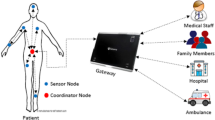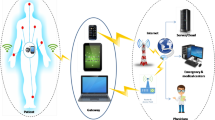Abstract
Burgeoning wireless technology developments have positively affected nearly every aspect of human life, and remote patient-healthcare monitoring through the internet is no exception. By employing smart gadgets, wireless body area networks, and cloud-based server platforms, patients can submit their sensor-captured readings in real-time to e-health cloud servers and ultimately to medical professionals so that the latter may treat patients appropriately at any time and in any place. To make the system reliable, an authenticated key agreement is required for the participating entities in this system. Many remote patient-healthcare monitoring protocols have been seen so far; however, reliance on wireless technology brings many security challenges for existing protocols. Recently, Xu et al. presented a new patient healthcare monitoring protocol; however, we demonstrate that it is vulnerable to many attacks, including replay attacks and key compromise impersonation attacks, and also that it suffers from privacy issues. Thereafter, we have proposed an improved scheme and formally analyzed its security features by implementing BAN logic and an automated simulation tool.







Similar content being viewed by others
References
Latré, B., Braem, B., Moerman, I., Blondia, C., & Demeester, P. (2011). A survey on wireless body area networks. Wirel Networks, 17(1), 1–18.
Irshad, A., Sher, M., Nawaz, O., Chaudhry, S. A., Khan, I., & Kumari, S. (2017). A secure and provable multi-server authenticated key agreement for TMIS based on Amin et al. scheme. Multimedia Tools and Applications, 76(15), 16463–16489.
Koblitz, N. (1987). Elliptic curve cryptosystems. Mathematics of Computation, 48, 203–209.
Miller, V. (1986). Uses of elliptic curves in cryptography. In H. C. Williams (Ed.), Advances in cryptology CRYPTO’85 (Vol. 218, pp. 417–426)., Lecture notes in computer science Berlin: Springer.
Irshad, A., Sher, M., Chaudhry, S. A., Kumari, S., Sangaiah, A. K., Li, X., et al. (2017). A secure mutual authenticated key agreement of user with multiple servers for critical systems. Multimedia Tools and Applications, 77, 11067–11099.
Azeem, I., Shehzad, A. C., Qi, X., Xiong, L., Mohammad, S. F., Saru, K., et al. (2017). An enhanced and provably secure chaotic map-based authenticated key agreement in multi-server architecture. Arabian Journal for Science and Engineering, 43, 811–828.
Azeem, I., Shehzad, A. C., Saru, K., Muhammad, U., Khalid, M., & Muhammad, S. F. (2017). An improved lightweight multiserver authentication scheme. International Journal of Communication Systems, 30, e3351.
Irshad, A., Sher, M., Chaudhry, S. A., Xie, Q., Kumari, S., & Wu, F. (2017). An improved and secure chaotic map based authenticated key agreement in multi-server architecture. Multimedia Tools and Applications, 77, 1167–1204.
Amin, R., Islam, S. H., Kumar, N., & Choo, K. K. R. (2018). An untraceable and anonymous password authentication protocol for heterogeneous wireless sensor networks. Journal of Network and Computer Applications, 104, 133–144.
Xu, Z., Xu, C., Chen, H., & Yang, F. (2019). A lightweight anonymous mutual authentication and key agreement scheme for WBAN. Concurrency and Computation: Practice and Experience, 31(14), e5295.
Reddy, A. G., Das, A. K., Yoon, E. J., & Yoo, K. Y. (2016). A secure anonymous authentication protocol for mobile services on elliptic curve cryptography. IEEE Access, 4, 4394–4407.
Jiang, Q., Ma, J., Wei, F., Tian, Y., Shen, J., & Yang, Y. (2016). An untraceable temporal-credential-based two-factor authentication scheme using ECC for wireless sensor networks. Journal of Network and Computer Applications, 76, 37–48.
Li, X., Niu, J., Kumari, S., Wu, F., Sangaiah, A. K., & Choo, K. K. R. (2018). A three-factor anonymous authentication scheme for wireless sensor networks in internet of things environments. Journal of Network and Computer Applications, 103(194–204), 1.
Aman, M. N., Chua, K. C., & Sikdar, B. (2017). A light-weight mutual authentication protocol for IoT systems. Paper presented at: 2017 IEEE global communications conference. Singapore.
Zhao, M., Yao, X., Liu, H., & Ning, H. (2016). Physical unclonable function based authentication protocol for unit IoT and ubiquitous IoT. Paper presented at: 2016 international conference on identification, information and knowledge in the internet of things (IIKI). Beijing, China.
Gope, P., & Hwang, T. (2016). An efficient mutual authentication and key agreement scheme preserving strong anonymity of the mobile user in global mobility networks. Journal of Network and Computer Applications, 62, 1–8.
Li, X., Niu, J., Kumari, S., Wu, F., & Choo, K. K. R. (2018). A robust biometrics based three-factor authentication scheme for global mobility networks in smart city. Future Generation Computer Systems, 83, 607–618.
Ibrahim, M. H., Kumari, S., Das, A. K., Wazid, M., & Odelu, V. (2016). Secure anonymous mutual authentication for star two-tier wireless body area networks. Computer Methods and Programs in Biomedicine, 135, 37–50.
Li, X., Ibrahim, M. H., Kumari, S., Sangaiah, A. K., Gupta, V., & Choo, K. K. R. (2017). Anonymous mutual authentication and key agreement scheme for wearable sensors in wireless body area networks. Computer Networks, 129, 429–443.
Janbabaei, S., Gharaee, H., & Mohammadzadeh, N. (2016). Lightweight, anonymous and mutual authentication in IoT infrastructure. Paper presented at: 2016 8th international symposium on telecommunications (IST). Tehran, Iran.
Dolev, D., & Yao, A. (1983). On the security of public key protocols. IEEE Transactions on Information Theory, 29(2), 198–208.
Hussain, S., & Chaudhry, S. A. (2019). Comments on “Biometrics-based privacy-preserving user authentication scheme for cloud-based industrial internet of things deployment”. IEEE Internet of Things Journal, 6(6), 10936–10940. https://doi.org/10.1109/JIOT.2019.2934947.
Mansoor, K., Ghani, A., Chaudhry, S. A., Shamshirband, S., Ghayyur, S. A. K. (2019). Securing IoT based RFID systems: A robust authentication protocol using symmetric cryptography. Sensors, 19(21), 4752. https://doi.org/10.3390/s1921475.
Mahmood, K., Arshad, J., Chaudhry, S. A., Kumari, S. (2019). An enhanced anonymous identity-based key agreement protocol for smart grid advanced metering Iinfrastructure. International Journal of Communication Systems, 32(16), e4137. https://doi.org/10.1002/dac.4137.
Li, M., Lou, W., & Ren, K. (2010). Data security and privacy in wireless body area networks. IEEE Wireless Communications, 17(1), 51–58.
Ghani, A., Mansoor, K., Mehmood, S., haudhry, S. A., Rahman, A. U., Saqib, M. N. (2019). Security and key management in IoT based wireless sensor networks: An authentication protocol using symmetric key. International Journal of Communication Systems, 32(16), e4139. https://doi.org/10.1002/dac.4139.
Al Ameen, M., Liu, J., & Kwak, K. (2012). Security and privacy issues in wireless sensor networks for healthcare applications. Journal of Medical Systems, 36(1), 93–101.
Amin, R., Islam, S. H., Biswas, G. P., Khan, M. K., & Kumar, N. (2018). A robust and anonymous patient monitoring system using wireless medical sensor networks. Future Generation Computer Systems, 80, 483–495.
Venkatasubramanian, K. K., Banerjee, A., & Gupta, S. K. S. (2010). Usable and secure key agreement scheme for body area networks. IEEE Transactions on Information Technology in Biomedicine, 14(1), 60–68.
Zhang, Z., Wang, H., Vasilakos, A. V., & Fang, H. (2012). ECG-cryptography and authentication in body area networks. IEEE Transactions on Information Technology in Biomedicine, 16(6), 1070–1078.
Alzahrani, B. A., Chaudhry, S.A., Barnawi, A., Al-Barakati, A., Alsharif, M. H. (2020). A privacy Ppeserving authentication scheme for roaming in IoT-based wireless mobile networks. Symmetry, 12, 287.
Sharma, G., & Kalra, S. (2019). A lightweight user authentication scheme for cloud-IoT based healthcare services. Iranian Journal of Science and Technology, Transactions of Electrical Engineering, 43(1), 619–636.
Alizadeh, M., Zamani, M., Baharun, S., Manaf, A. A., Sakurai, K., Anada, H., et al. (2015). Cryptanalysis and improvement of “a secure password authentication mechanism for seamless handover in proxy mobile IPv6 networks”. PLoS ONE, 10(11), e0142716.
Burrow, M., Abadi, M., & Needham, R. (1990). A logic of authentication. ACM Transactions on Computer Systems, 8, 18–36.
Hassan, M. U., Chaudhry, S. A., & Irshad, A. (2020). An improved SIP authenticated key agreement based on Dongqing et al. Wireless Personal Communications 110(4), 2087–2107.
Jiang, Q., Ma, J., Yang, C., Ma, X., Shen, J., & Chaudhry, S. A. (2017). Efficient end-to-end authentication protocol for wearable health monitoring systems. Computers & Electrical Engineering, 63, 182–195.
Zhao, Z. (2014). An efficient anonymous authentication scheme for wireless body area networks using elliptic curve cryptosystem. Journal of Medical Systems, 38(2), 13.
Blanchet, B. (2005). ProVerif automatic cryptographic protocol verifier user manual. Departement dInformatique, Ecole Normale Superieure, CNRS: Paris.
Amin, R., Islam, S. H., Gope, P., Choo, K. K. R., & Tapas, N. (2018). Anonymity preserving and lightweight multi-medical server authentication protocol for telecare medical information system. IEEE Journal of Biomedical and Health Informatics, 23, 1749–1759.
Amin, R., Islam, S. H., Biswas, G. P., Khan, M. K., & Kumar, N. (2015). An efficient and practical smart card based anonymity preserving user authentication scheme for TMIS using elliptic curve cryptography. Journal of Medical Systems, 39(11), 180.
Shen, J., Gui, Z., Ji, S., Shen, J., Tan, H., & Tang, Y. (2018). Cloud-aided lightweight certificateless authentication protocol with anonymity for wireless body area networks. Journal of Network and Computer Applications, 106, 117–123.
Chaudhry, S. A., Shon, T., Al-Turjman, F. and Alsharif, M. H. (2020). Correcting design flaws: An improved and cloud assisted key agreement scheme in cyber physical systems. Computer Communications, 153, 527–537.
He, D., & Zeadally, S. (2015). Authentication protocol for an ambient assisted living system. IEEE Communications Magazine, 53(1), 71–77.
Acknowledgements
This Project was funded by the Deanship of Scientific Research (DSR), at King Abdulaziz University, Jeddah (SA), under grant no. RG-13-611-38. The authors, therefore, acknowledge with thanks DSR for technical and financial support.
Author information
Authors and Affiliations
Corresponding author
Additional information
Publisher's Note
Springer Nature remains neutral with regard to jurisdictional claims in published maps and institutional affiliations.
Rights and permissions
About this article
Cite this article
Alzahrani, B.A., Irshad, A., Albeshri, A. et al. A Provably Secure and Lightweight Patient-Healthcare Authentication Protocol in Wireless Body Area Networks. Wireless Pers Commun 117, 47–69 (2021). https://doi.org/10.1007/s11277-020-07237-x
Published:
Issue Date:
DOI: https://doi.org/10.1007/s11277-020-07237-x




